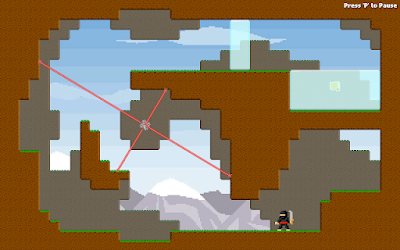I launched Bullet Time Ninja on Kongregate in late January. The audience reception has been surprisingly polarized.
http://www.kongregate.com/games/KWarp/bullet-time-ninja
Players that figured out how to play the game, loved it. The game's average rating was above 3.7 (out of 5) after about 5,000 plays. Unfortunately, players that could not figure out how to play the game, absolutely hated it. Worse, the number of haters grew as the game got more exposure. By the end of the third day on Kongregate, the game had over 30,000 views, and a rating of 3.2 out of 5.
What the hell happened?
Let's take a look at the numbers:
This graph is the total number of players that completed each game level after 300 plays. Most players were friends or random USC students. With only a 10% completion drop on Level 1, and all signs pointed to a relatively smooth learning curve.
This graph is the collective total of players that completed each game level after 60,000 plays. Approximately 24.2% of players did not finish Level 1. Somehow, I failed to teach a sizable portion of players how to play the game. This completely caught me by surprise.
The people who didn't like the game made some blunt comments. Let's read through a few choice quotes:
stupid game 1/5
The problem with this game is it isn't fun.
i have a really hard time figuring out how to play this game, i feel it shouls be easer to dash.. just can t get the hang of it
Feels really unnatural having S be the jump key and A be the focus key...
Controls would not be too bad if space was dash or jump and s was the other one. Or even W for jump, A to Focus, and D to dash. Just basically something other than what it is now.
is this really all it takes to get badges? wow, i should totally become a game developer. its not totally horrible, but giving this a 2. the controls are absolutely atrocious
Rather awful. Spend your time elsewhere, this game blows
To have this game's release conclude with a slew of nasty comments really hurts. Had I made a nice amount of money from this game, I probably wouldn't care. However, as of early February, the game has not even made $100 in total revenue. I need $600 to break-even on my development budget. What's worse is that these comments and bad ratings have directly prevented the game from gaining further exposure. Was my design so wrong that the game deserved it?
The main complaints from players could be summed up as the following:
- You are not telling me how to play the game
- The controls "don't work"
- The game controls should be like this.... (Customizable Key Controls)
The first complaint was both a design error and a demographic error. I was overconfident with my level design, and I assumed that most players were smart enough to figure out this game's steep learning curve with minimal guidance. In response to player complains, I made careful revisions to Level 1, literally posting signs that tell players what the controls are... yet the numbers still show that around 20% of players can't figure it out. Kongregate's demographic is simply not an ideal one for my game.
The second complaint is a stupid hardware problem called
Key Jamming. A large number of computer keyboards simply cannot detect when 3 or more keys are held down at the same time. Unfortunately for me, Bullet Time Ninja needs to detect 4 keys being held at the same time for an optimal experience. There is nothing I can do to solve this problem, and ignorant players just assume that I did a crappy job. I think this is why Platformer games are still primarily sold on game consoles.
The third complaint highlights how emotionally attached players are to control schemes that they have already learned. Many players wanted A and S to be swapped, while others wanted WASD + JK to be the primary controls. There is no way to accomodate all of these needs in one control scheme, so I went out of my way to implement a complete customizable control menu.
Despite my changes to address player complaints, it looks like the damage has already been done. Bullet Time Ninja was not mentioned in the weekly Kongregate newsletter, and has not picked up press from any Game Development blogs.
These results are just not enough to justify the time or money that I put into this project. I don't think Independent Games are worth my time any more.
.
..
...
Although, comments like these, sometimes make the whole process worthwhile:













